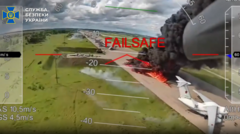Ukraine's recent Operation Spider's Web, a surprise drone attack on Russian airbases, has showcased its military ingenuity and delivered a significant blow to Russia's strategic aviation capabilities, raising questions about the future landscape of the conflict.**
Ukraine’s Operation Spider's Web: A Strategic Shift in Drone Warfare**

Ukraine’s Operation Spider's Web: A Strategic Shift in Drone Warfare**
A deep dive into the implications of Ukraine's recent drone assaults on Russian airfields, detailing operational success and potential shifts in the ongoing conflict.**
Three days after the significant Operation Spider's Web, Ukraine continues to assess the profound impact of this monumental drone offensive against Russian airbases. On Wednesday, the Security Service of Ukraine (SBU) unveiled striking drone footage from the operation, along with satellite images depicting the destruction at Olenya, Ivanovo, Dyagilevo, and Belaya airbases.
Military analysts in Ukraine are heralding the operation as one of the most effective and innovative strikes in their military history. Roman Pohorlyi, founder of DeepState, remarked, "This can be considered one of the most brilliant operations in our history," highlighting the message of strength and creativity this assault sends to their adversary.
With the SBU eager to promote the success of the operation, President Volodymyr Zelensky claimed that it resulted in the damage or destruction of 41 aircraft, with many being irreparable or facing extensive repair delays. "If there had been a ceasefire, Operation Spider's Web would not have occurred," Zelensky stated, emphasizing the significance of this moment in the wider context of the conflict.
Emerging footage illustrates the targeted strikes on Russian bombers, transport aircraft, and airborne warning systems, revealing that many drones meticulously aimed at vulnerable points such as fuel tanks, amplifying the impact of the attack. One notable section of the imagery highlights drones zeroing in on Beriev A-50s—airborne warning and control aircraft critical to Russian aerial operations.
The assault may have severely reduced Russia’s A-50 fleet, with analysts suggesting that its ability to replace losses has become increasingly compromised due to logistical challenges. As military expert Serhii Kuzan pointed out, replacing lost A-50s remains improbable under current conditions.
Additionally, the SBU disclosed innovative tactics employed during the operation, including unique transportation methods for the armed drones. Footage showed drones concealed within specially designed containers, which were later deployed for a strategic surprise. This further underscores the operational readiness and creative approaches Ukrainian forces are adopting.
Experts are now contemplating the long-term implications of such an operation. Aviation specialist Anatolii Khrapchynskyi labeled it a turning point in the war, theorizing that Ukraine has effectively exposed vulnerabilities within Russian defenses, presenting them as unable to protect their assets.
Notably, reactions to the operation extend beyond Kyiv, with international figures echoing sentiments about Ukraine's newfound military prowess. Following discussions with Ukrainian President Zelensky, Donald Trump noted Russia's forthcoming response to these strikes, indicating that tensions remain high and that the road to peace is fraught with challenges.
As the situation evolves, Operation Spider's Web stands as a critical moment in the ongoing conflict, demonstrating Ukraine's tactical evolution and their resolve to confront Russian aggression head-on.





















